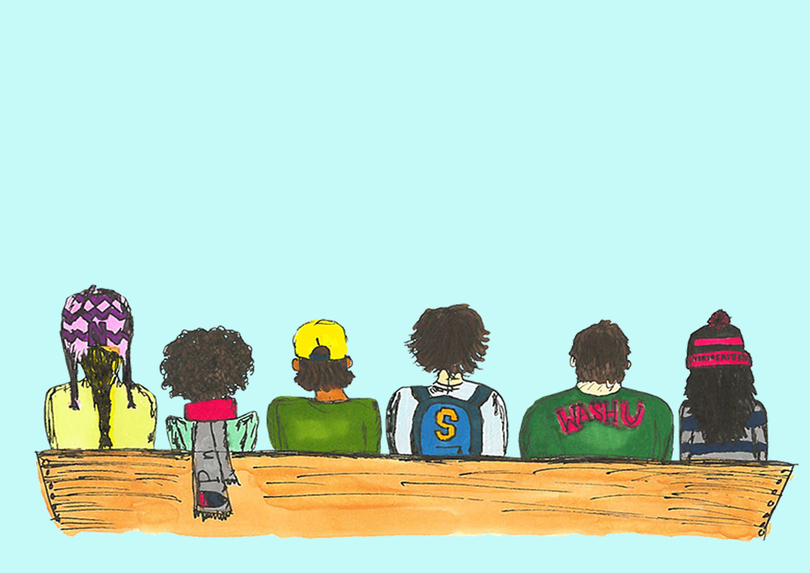Officials detail why certain ‘benchmark’ colleges were cited in a Syracuse University community investments analysis

Audra Linsner | Staff Illustrator
Two high-ranking Syracuse University administrators on Wednesday provided additional clarification as to why several “benchmark” universities were cited in a report that indicates SU is reassessing community investments throughout the city.
The report, compiled by Seattle-based boutique consulting firm Enlight Advisors, was released earlier this semester. It came two weeks after Syracuse.com reported the university was pulling back financial support for the Near Westside Initiative, a project spearheaded by former Chancellor Nancy Cantor’s administration.
“To be clear, it’s not that we have made such an assessment at this point. But, it could be that there are things we have focused on, in the context of community engagement, that are misaligned with the future aspirations of the institution,” said Mike Haynie, SU’s vice chancellor for strategic initiatives and innovation. “In those instances, it becomes an exercise in understanding if we can realign, shift that engagement and position in different ways.”
When previously asked if SU strives to be like the “benchmark” universities it compared its community investment strategies to in the report, SU Vice President for Community Engagement Bea González said the university is “looking for best practices.”

Anna Henderson | Contributing Digital Design Editor
The five major universities listed in the report as benchmarks were: Northeastern University, Northwestern University, the University of Pennsylvania, the University of Pittsburgh and Washington University at St. Louis. Secondary research for the report was also conducted at: The State University of New York College of Environmental Science and Forestry; the State University of New York Upstate Medical University; Le Moyne College; the University of Rochester; the Rochester Institute of Technology; Cornell University; Vanderbilt University; and the University of Michigan.
Haynie said university administrators discussed what peer institutions or “aspirational peers” to include in the report with an Enlight consultant.
Certain universities were selected as “aspirational” benchmarks because they were informative of what SU wants to be, the vice chancellor said. The colleges were also roughly similar in regard to how they are resourced and organized, he said.
All of the major benchmark universities listed in Enlight’s study have published similar reports or findings on their own regional economic impacts, detailing local investments like SU. For example, Washington University at St. Louis estimated that in fiscal year 2016, the university supported more than 43,000 jobs throughout the St. Louis area.
UPenn, meanwhile, contributed $10.8 billion to Philadelphia’s economy in fiscal year 2015, according to a report by consulting firm Econsult Solutions, Inc. Northeastern plans to spend more than $100 million to help Boston renovate and maintain a city playground. SU, under Cantor’s leadership, pumped millions of dollars into big community projects such as the Connective Corridor and Near Westside Initiative.
In a separate economic analysis report recently prepared for SU, an Idaho-based consultant called Emsi estimated that the university had a $1.1 billion economic impact on the surrounding central New York region, the equivalent of supporting 15,481 jobs.
A key takeaway for administrators, after analyzing the benchmarks, is that there’s no “one size fits all solution for how to do this well,” Haynie said. Each university has to take into consideration the very specific conditions of surrounding areas when determining community investment strategy, both González and Haynie said.

Anna Henderson | Contributing Digital Design Editor
“If we just look at our statistics in this region, all of our efforts haven’t helped alleviate some major issues in this community,” González said. Syracuse, according to a 2015 report by a think tank, has the most concentrated minority poverty out of the 100 largest metropolitan areas in the country. About 41,710 people in the city lived below the federal poverty line in 2016, according to United States Census Bureau estimates.
González has previously said she wants SU to help better address multigenerational poverty in Syracuse. On Wednesday, she said the university is having “conversations” with the South Side Innovation Center and equity unit of CenterState CEO about expanding the “entrepreneurial fabric” on the South Side, a traditionally low-income community southwest of Main Campus.
But in early October, Syracuse.com reported that SU was pulling back its financial support for the Near Westside Initiative, a 2006 project launched under Cantor’s “Scholarship in Action” philosophy in hopes of revitalizing one of the city’s lowest-income communities. In an October interview, González said SU’s committment to the Near Westside neighborhood is not over, “it’s just different.”
“I also want a better understanding of expectations,” González said on Wednesday. “I think if we’d had some of those conversations, and those things documented, we might not have found ourselves in this situation of being seen as withdrawing from an organization, or an investment, or a community, when … from the onset … sustainability was a value and an expectation.”
Listed in Enlight’s report are four “important” differences between the university’s community investments strategy and the benchmarks’. In the list, Enlight notes that unlike SU, the benchmarks “do not consider access scholarships to be part of their community investment efforts.” According to Emsi’s economic analysis, SU invests $20.7 million annually in regional access scholarships for more than 800 “underserved and talented students” in central New York.
When asked if the benchmark findings will influence SU to change how it handles access scholarships, Haynie said all he wants to do is “celebrate” access programs including Syracuse Say Yes to Education, which provides financial aid to lower-income students living in the area.
“I think we should continue to give kids a chance,” he said.




